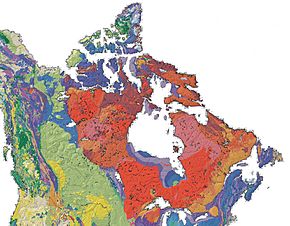Athabasca Basin facts for kids
The Athabasca Basin is a special area in northern Saskatchewan and Alberta, Canada. It's part of the huge Canadian Shield. This basin is famous for having a lot of high-quality uranium. In fact, it provides about 20% of the world's uranium supply!
Where is the Athabasca Basin?
The Athabasca Basin is located south of Lake Athabasca. It is also west of Wollaston Lake and surrounds almost all of Cree Lake. This large area covers about 100,000 square kilometers (38,610 square miles). Most of it is in Saskatchewan, with a small part in Alberta.
The ground in the basin is mostly made of sandstone. This sandstone layer can be from 100 to 1,000 meters (328 to 3,280 feet) deep. The valuable uranium ore is usually found deep down. It sits where the sandstone meets the older rock below, called the basement.
Communities and Nature
Around the edges of the basin are several communities. These include Fort Chipewyan in Alberta. In Saskatchewan, you'll find Camsell Portage, Stony Rapids, Fond du Lac, Black Lake, and Wollaston Lake.
A big part of the Athabasca Basin is a travel path for the Beverly caribou herd. These caribou are a very important food source for the Denesuline communities living there.
Inside the basin, there are also some interesting natural spots. You can find the Athabasca Sand Dunes Provincial Park on the south shore of Lake Athabasca. There's also the Carswell crater, which is a large impact crater. The Cluff Lake mine used to operate in this crater area.
Points North Landing is a permanent supply base and camp. It helps provide supplies to the eastern part of the basin. You can reach the area by road using Saskatchewan Highway 955 from La Loche on the west side. On the east side, you can use Saskatchewan Highway 914 and Saskatchewan Highway 905 from La Ronge.
Uranium Mines
People first found uranium in this region in the 1940s. The very first mine to open here was the Rabbit Lake Mine. It was discovered in 1968 and started operating in 1975.
Today, one of the most important mines is Cameco's McArthur River mine. It is known as the world's largest mine for high-grade uranium. Other important uranium mines in the Athabasca Basin include the Cigar Lake Mine, the Key Lake mine, and the McClean Lake mine. The Cluff Lake mine is another well-known mine, but it is now closed.
Images for kids




